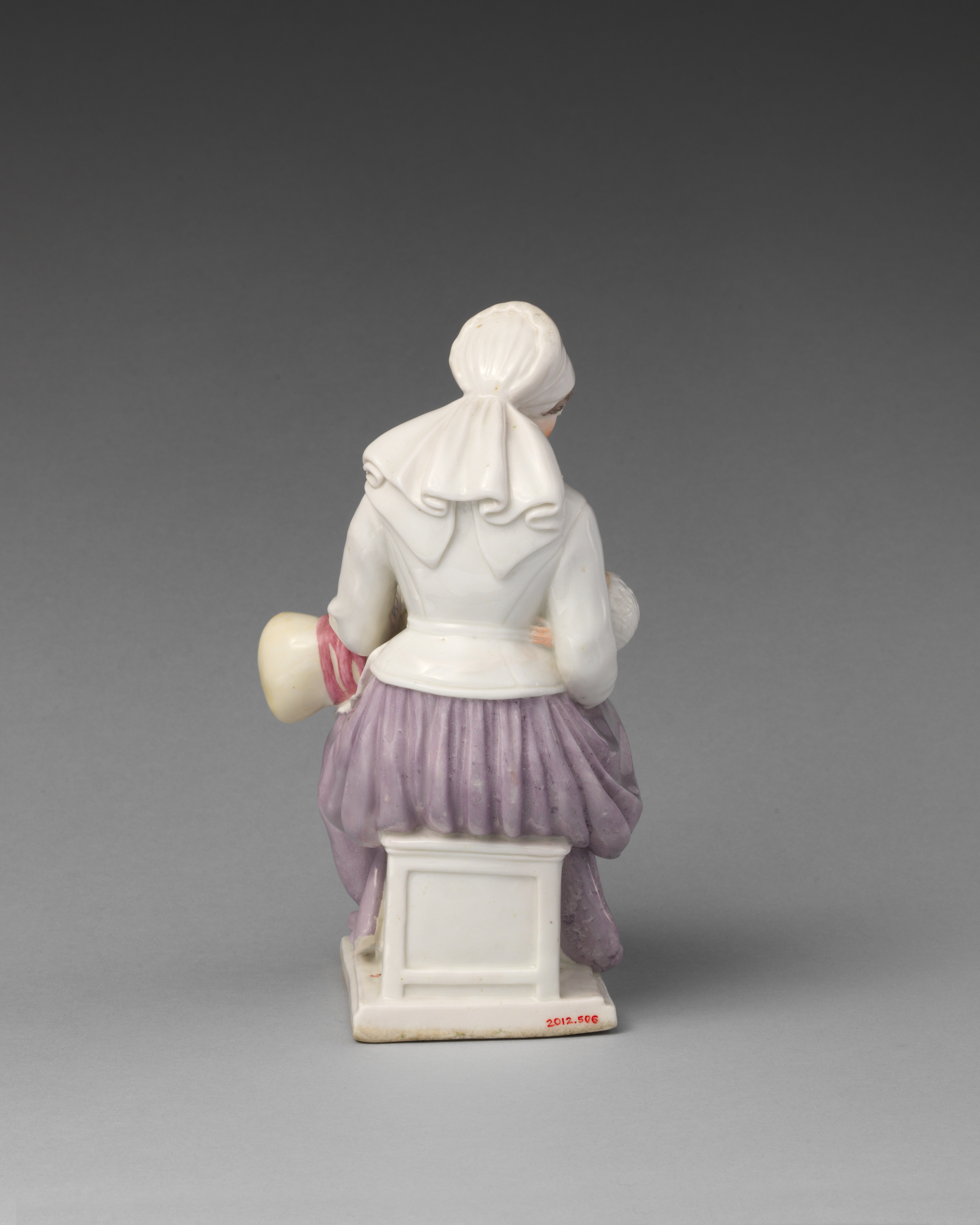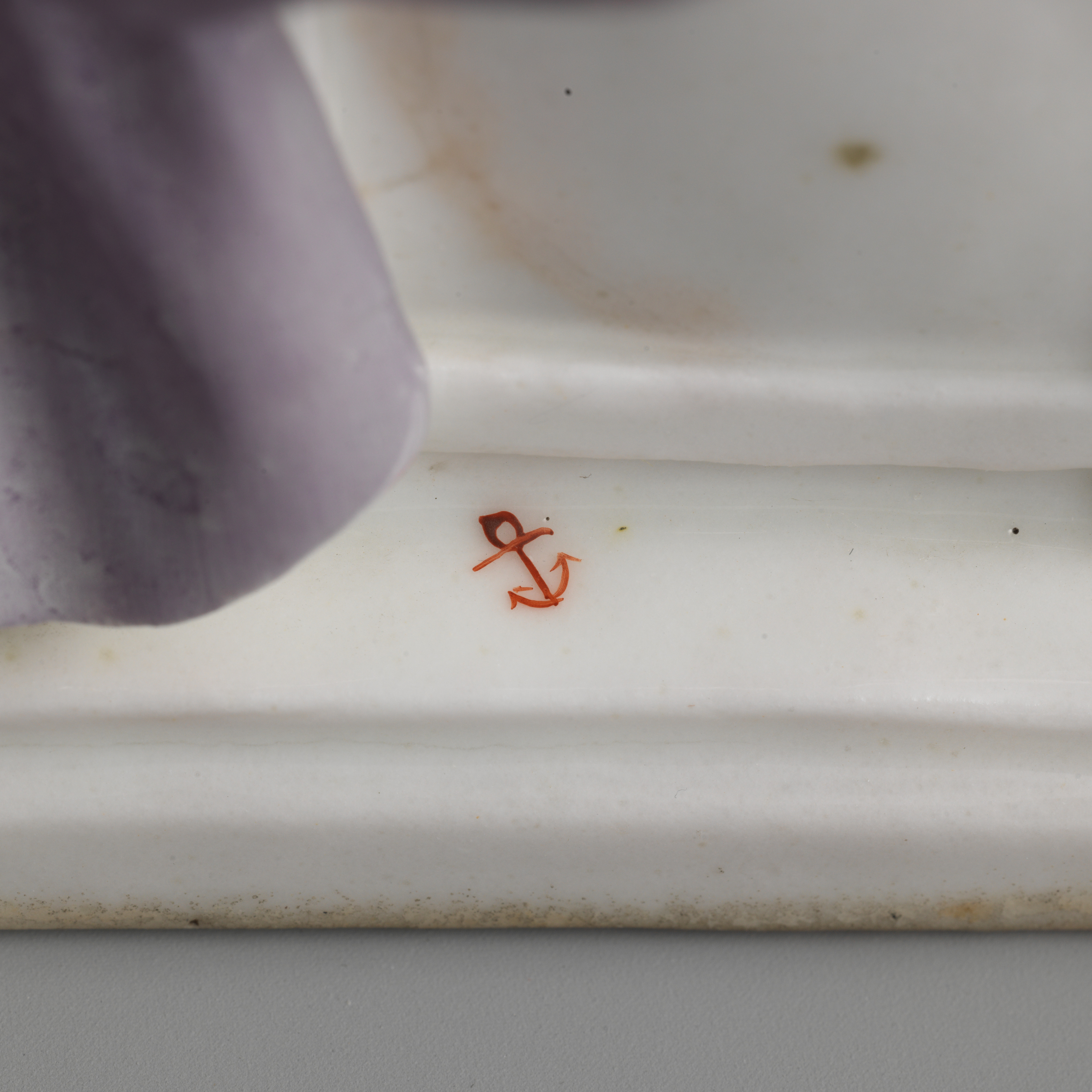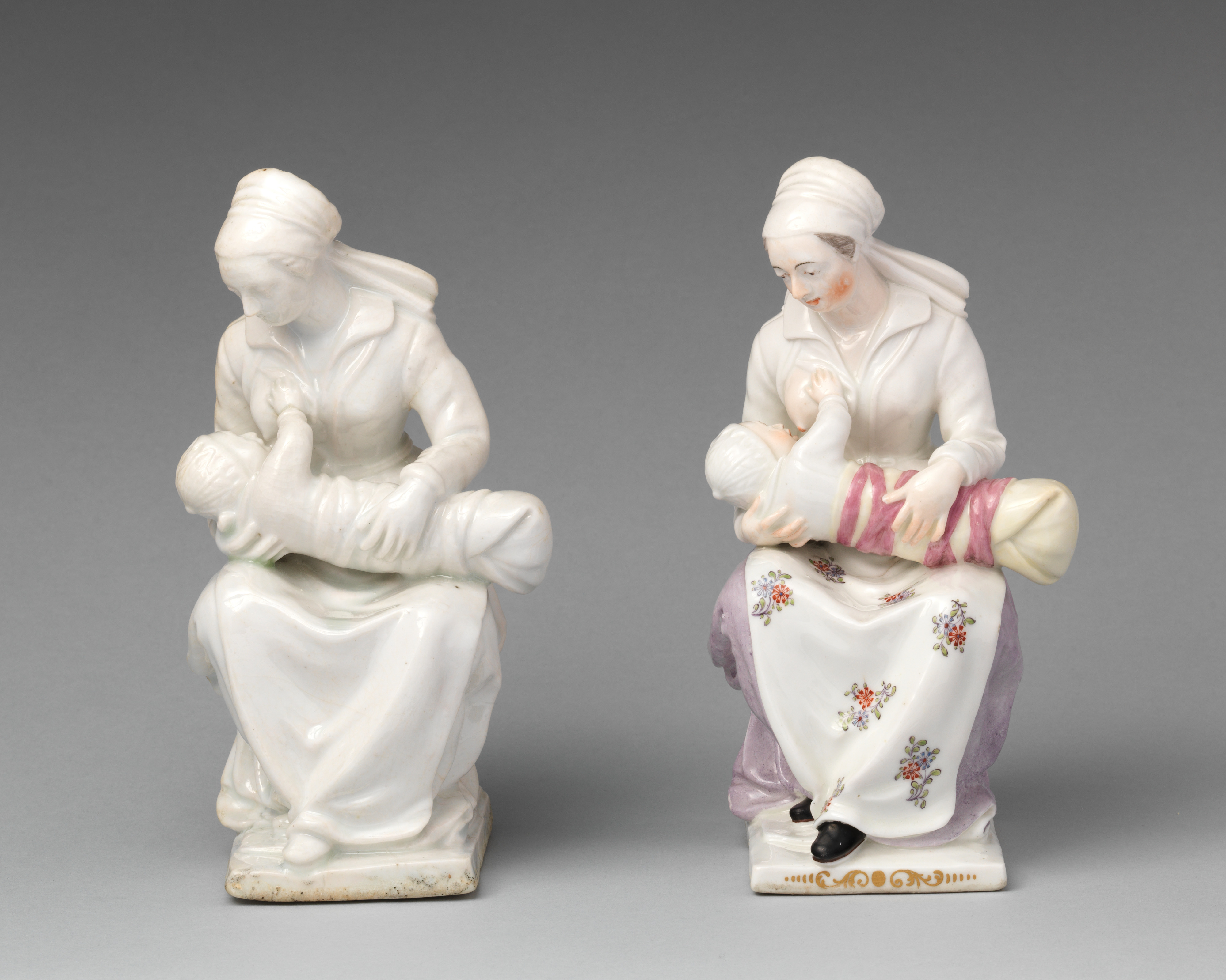La Nourrice
Manufactory Chelsea Porcelain Manufactory British
Modeler Joseph Willems Flemish
Not on view
The production of figures was a major focus for the Chelsea factory for much of its history, and the prominence accorded to figural work coincided with the arrival of the modeler Joseph Willems (Flemish, 1715/16–1766) at the factory in 1748, at which time his name is first recorded. Like Nicholas Sprimont (Walloon, 1716–1771),[1] Willems was from the Low Countries, and it is clear that he was a capable sculptor by the time of his arrival in England,[2] although nothing is known of his training prior to 1748. It appears that Willems assumed complete responsibility for the factory’s porcelain sculpture upon his employment, and all of the models introduced between around 1749 and 1766 are regarded as his work.[3] Willems’s output at Chelsea was prodigious, and while he drew on a wide variety of sources for his figures and groups, he created what amounted to a factory style, as has been observed by Hilary Young.[4] Willems’s versatility is evident by the types of figures he created, including the Italian commedia dell’arte, street merchants, chinoiserie figures, birds and animals, and figures personifying the Five Senses. Although he frequently looked to the work of other artists, and to the figures of Johann Joachim Kändler (German, 1706–1775) at Meissen in particular, Willems’s skill as a modeler ensured that his figures transcended mere copying.
Willems’s seated woman nursing a baby was one of the most popular figures made at Chelsea and produced over a number of years. The model first appeared during the Raised Anchor period (1749–52); however, the majority of surviving examples date from the second half of the 1750s and thus bear the red anchor mark used during those years.[5] This model of a nursing woman is known as La Nourrice, and its French name derives from the seventeenth-century French pottery figures of the same composition, one of which must have served as the source for Willems’s figure. It seems that a sizable number of lead-glazed earthen-ware examples of a seated woman nursing a child were produced in the early years of the seventeenth century. These figures are thought to have been made in Fontainebleau, the site of one of the most important royal châteaux, or in neighboring Avon, and a variety of names have been proposed as the author of the model (fig. 51). Guillaume Dupré (French, 1579–1640), sculptor to Henry IV (1553–1610), king of France, is often credited with creating the model for this figure,[6] but this attribution remains speculative. The French versions of La Nourrice are dated to the early seventeenth century due to a document that records the gift in 1608 of a pottery figure of a nurse, presumably of the same model, to the daughter of Madame de Montpensier.[7] It is not known who actually made the figures of La Nourrice, although the names of several potters are known who were producing ceramics for the upper strata of society, including those of Claude Bérault (French, dates unknown), Claude Berthélemy (French, ca. 1555–1626), and Berthélémy de Blènod (French, active early 17th century). Very little is known about these men or their workshops, and it is possible that figures of La Nourrice were made at more than one pottery, especially given the clear popularity of the model. This supposition is strengthened by the fact that the two French examples of La Nourrice from the early seventeenth century in the Museum show subtle but significant differences in terms of their modeling, detailing, and types of glazes used.[8] However, it is not impossible that these differences can be explained by the reworking of molds necessitated by extensive use, resulting in small differences created by each reworking.
While much remains to be discovered about the French pottery examples of La Nourrice, it seems clear that one of them must have been made available to Willems at Chelsea. Willems’s figure closely follows all the compositional elements of the French models, and the similarity of the treatment of the back of Willems’s figure to that of the French versions indicates that he had access to a three-dimensional model rather than having to work from a print. The availability of a French example raises many questions, including why and when did one or more of these figures go to England, who would have acquired one and where, and how was one made available to the Chelsea factory. In regard to the last question, it is possible that one of Sprimont’s wealthy clients or backers owned a French example of La Nourrice and either suggested that it be copied at Chelsea or requested a version in soft-paste porcelain, but this is entirely speculative. The creation of La Nourrice at Chelsea proved to be an astute business decision, as the numerous surviving examples attest to its considerable popularity, which was long- lived. The molds for the figure would have required reworking numerous times due to the many examples produced, which may explain the slight differences visible between the Museum’s Raised Anchor version of the early 1750s (fig. 52), and the version made in the mid to late 1750s in the following Red Anchor period (ca. 1752–58). The later figure is more crisply modeled and defined, and those qualities, in combination with the accomplished but restrained enamel decoration, result in a much more refined piece of porcelain sculpture.
It is not clear why the figure of a wet nurse with a suckling child, based upon an early seventeenth- century French pottery model, exerted appeal in England in the mid-eighteenth century, but its popularity was such that the model was copied at the Liverpool factory of Richard Chaffers (British, d. 1765) around 1760,[9] and it was also produced in Staffordshire in creamware (lead-glazed earthenware).[10]
Footnotes
(For key to shortened references see bibliography in Munger, European Porcelain in the Metropolitan Museum of Art. NY: The Metropolitan Museum of Art, 2018)
1 Sprimont was from Liège in what is now eastern Belgium, and as the region is known as Wallonia, its
residents are called Walloons.
2 The terracotta figure Man in Ragged Clothes signed and dated 1736 by Willems measuring H. 29 1/4 in. (74.3 cm) was acquired by the Metropolitan Museum in 2013 (2013.601).
3 H. Young 1999, p. 106.4 Ibid.
5 The various periods at Chelsea are defined by the factory marks employed, but there is a lack of consensus in the Chelsea literature in defining the parameters of each period. Hilary Young (1999, p. 197) suggests the following: Triangle period, 1745–49; Raised Anchor period, 1749–52; Red Anchor period, ca. 1752–58; and Gold Anchor period, 1758–69.
6 Wardropper 2004, p. 44; Viennet 2010, p. 92.
7 Wardropper 2004, p. 44. In this instance, Madame de Montpensier refers to Henriette Catherine de Joyeuse (1585–1656).
8 MMA 17.190.2057; 1974.356.303.
9 Watney 1997, p. 118, fig. 468; Sotheby’s, London, sale cat., May 24, 2006, no. 68.
10 Historic Deerfield, Deerfield, Mass. (HD 2006.33.105).
Due to rights restrictions, this image cannot be enlarged, viewed at full screen, or downloaded.
This artwork is meant to be viewed from right to left. Scroll left to view more.






